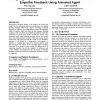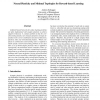370 search results - page 23 / 74 » How to Control Emergence of Behaviours in a |
PERSUASIVE
2009
Springer
14 years 2 months ago
2009
Springer
Experiencing emotional distress is the number one reason why people who are undergoing behaviour modification (e.g. quitting smoking, dieting) suffer from relapses. Providing emot...
IJCIM
2002
13 years 7 months ago
2002
This paper presents a new distributed real-time control architecture for flexibly automated production systems. The modelling assumptions underlying the design en by, and abstract,...
IJSNET
2010
13 years 2 months ago
2010
Abstract: Taking into account requirements of sensor networks, we need fully-distributed and selforganising control mechanisms which are scalable to the size of a network, robust t...
HIS
2008
13 years 9 months ago
2008
Artificial Neural Networks for online learning problems are often implemented with synaptic plasticity to achieve adaptive behaviour. A common problem is that the overall learning...
WOWMOM
2005
ACM
14 years 1 months ago
2005
ACM
Emerging ubiquitous computing leverages the need for automated trust management models. We take a domestic network of both fixed and mobile nodes as our reference scenario and in...



